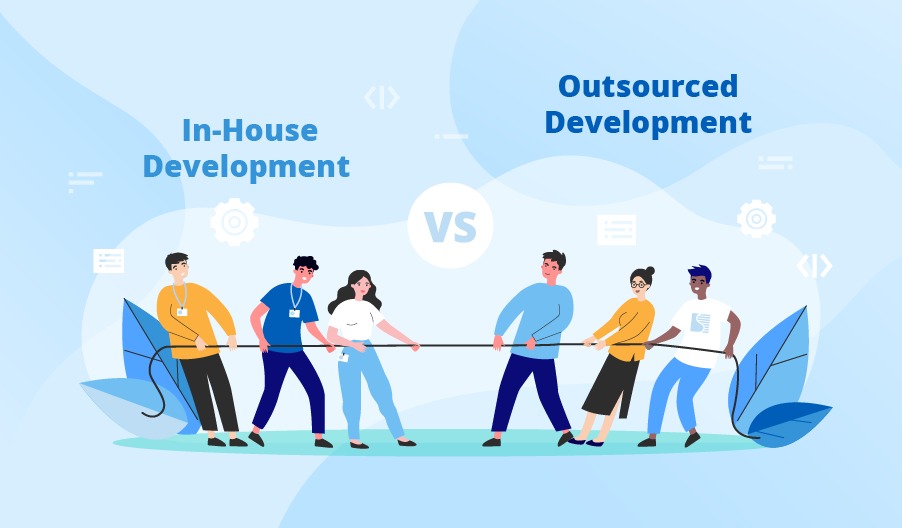 News
News
Software development is extremely important for businesses nowadays. Even startups could benefit highly from software development as it brings many advantages to the business. It helps them implement new and innovative strategies and advancements to their website and projects and helps them to stay ahead in the digital world. Therefore, the demand for software developers has increased, and believe it or not, the worldwide population of software developers is bound to touch 28.7 million by the end of 2024. When businesses want to develop software, they have to decide if they want to do it in-house (within their own company) or if they want to hire another company nearby (nearshore outsourcing) to do it for them. Both choices have good and bad sides, but it's really important to know how much it'll cost so you can choose the best option. In this blog post, we’ll guide you through a complete breakdown of in-house vs. nearshore software development expenses to allow you to make an informed decision for your firm!
In-House vs. Nearshore Software Development Expenses
In-House Software Development Expenses
As discussed above, in-house software development refers to the process of building software solutions using an internal team of developers and resources. This approach offers several benefits, including greater control over the development process, easier communication, and alignment with company culture and objectives. However, it also comes with its fair share of expenses. Below, we discuss several major expenses that companies and startups have to deal with when opting for in-house hiring.
People Costs
When you decide to create software within your company, you need to find and hire the right people. These people include developers who write the actual code to make the software work, project managers who organize and coordinate the work of the team, and quality assurance specialists who test the software to make sure it works correctly and doesn't have any bugs. These individuals are usually very skilled at what they do, and they expect to be paid well and receive benefits like health insurance and paid time off because of their expertise and the important role they play in the project.
Infrastructure Costs
Making software requires more than just people; it also requires tools and a suitable workspace. You need computers for your team to work on, software licenses to use the necessary programs, and physical space for everyone to come together and collaborate, much like how a carpenter needs tools and a workshop to build a house. Just as a house needs regular maintenance to stay in good shape, computers, and software also need updates and occasional repairs to keep running smoothly and efficiently. These costs can add up over time.
Training and Learning
Technology is always evolving and changing. It's like when you learn new things in school each year. To keep up with the latest advancements and best practices in software development, your team needs to continually learn and improve their skills. This might involve attending classes, workshops, or conferences, or even just reading books and articles to stay updated. Investing in ongoing training ensures that your team remains knowledgeable and capable of producing high-quality software that meets the needs of your business and customers.
Overhead Expenses
Running a business, whether it's making software or something else, comes with additional expenses beyond just the direct costs of production. It's similar to the bills you pay to keep your house running smoothly, like electricity, water, and insurance. For a company, overhead expenses include things like utilities for the office, insurance policies to protect the business and its employees, taxes that must be paid to the government, and various administrative costs associated with day-to-day operations. While these expenses may not be directly tied to the process of making software, they still contribute to the overall cost of running the business and need to be accounted for in the budget.
Time and Opportunity Costs
When your company decides to make software in-house, it also means investing a lot of time and resources into the project. This time commitment means your team might have to choose software development over other important projects or tasks that could help the company in different ways. This is called opportunity cost—what you could have gained by using your resources on other things. Also, developing software internally might take longer, which could delay when your product is ready to be sold or used by customers. This delay might mean you lose out on making money sooner or being ahead of your competition. So, while you think about the money you spend on making software, it's also important to think about the time and opportunities you're using up along the way.
Nearshore Software Development Expenses
Nearshore software development hiring means hiring teams or individuals from nearby countries or regions to build software solutions. You can find more details on nearshore hiring in our linked blog post. This method gives you control over the process, makes communication easier, and aligns with your company's culture and goals. However, it also involves costs. Let's look at some of the main expenses companies face when choosing nearshore software development hiring.
Hourly Rates and Labor Costs
Nearshore software development involves hiring teams or individuals from neighboring countries or regions with lower labor costs compared to your local market. However, you still need to pay for the services rendered. While nearshore rates might be lower than onshore rates, they still represent a significant portion of your budget. However, you can also save up by opting for nearshore staff augmentation instead!
Project Management and Communication Tools
Effective communication is crucial for successful nearshore software development. You'll likely incur expenses for project management tools, such as Asana, Trello, or Jira, to track progress, assign tasks, and coordinate activities across distributed teams. Additionally, investing in communication platforms like Slack, Zoom, or Microsoft Teams ensures smooth collaboration and reduces misunderstandings.
Travel and Accommodation
Nearshore software development often involves periodic visits to your outsourcing partner's location or hosting them at your office. Travel expenses, including airfare, accommodation, transportation, and meals, can accumulate quickly. These visits facilitate face-to-face meetings, team building, and alignment on project goals, ultimately enhancing collaboration and project outcomes.
Legal and Contractual Fees
Engaging in nearshore software development requires formal agreements and contracts to define project scope, timelines, deliverables, and payment terms. Legal consultations, contract drafting, and review processes entail expenses. You might also have to deal with fees related to compliance with local regulations, intellectual property protection, and dispute resolution mechanisms, ensuring a legally sound partnership.
Cultural and Time Zone Alignment
Nearshore software development often involves working with teams from different cultural backgrounds and time zones. While these factors offer advantages like diverse perspectives and extended work hours, they also require investment in cultural awareness training and strategies to mitigate communication barriers and promote cohesion among team members. Furthermore, coordinating meetings and ensuring overlapping work hours across time zones may necessitate scheduling tools or services, adding to the overall expense.
In-House vs. Nearshore Software Development - Making an Informed Decision
In summary, while both in-house and nearshore software development involve costs, choosing nearshore development can be more cost-effective and efficient. Nearshore outsourcing allows businesses to hire skilled teams from nearby regions at lower rates, saving money while maintaining quality. Another point to note is that as per a study, those who work from home spend 10 minutes less a day being unproductive, work one more day a week, and are 47% more productive. With good communication tools, occasional travel for meetings, careful legal considerations, and attention to cultural differences and time zones, nearshore development offers a practical solution for businesses looking to optimize resources and speed up projects. Partnering with trusted nearshore companies like Blue Coding can help businesses leverage expertise and achieve success in the digital world.
Hire Nearshore Developers With Blue Coding's Staff Augmentation Services
Blue Coding is a leading nearshore software development company that specializes in providing high-quality development services to businesses worldwide. With a focus on delivering cost-effective solutions without compromising on quality, We offer a diverse team of skilled developers, project managers, nearshore staff augmentation experts, and quality assurance specialists who work collaboratively to bring client's visions to life. Leveraging its expertise in nearshore outsourcing, Blue Coding helps companies reduce development costs, improve scalability, and accelerate time-to-market for their software projects. If you'd like to hire nearshore development experts or if you simply wish to learn more about our services, feel free to contact us now!




